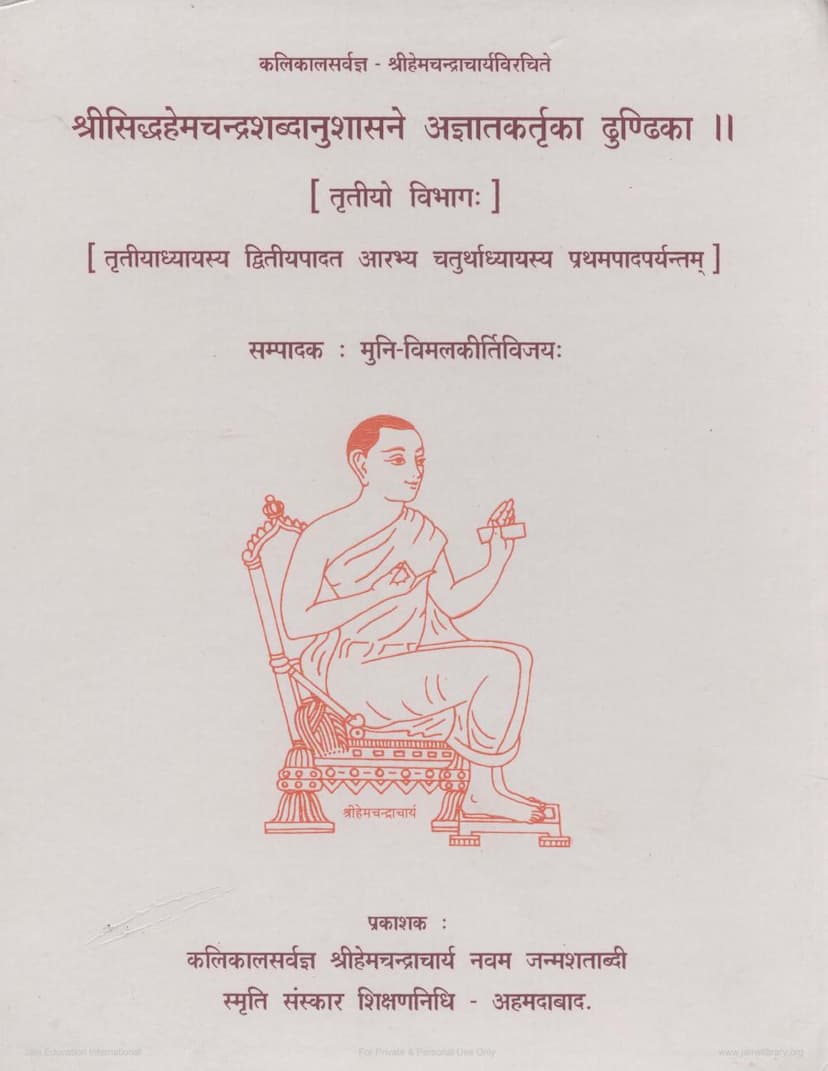Siddha Hemchandra Shabdanushasane Agyat Kartuka Dhundika Part 03
Added to library: September 2, 2025

Summary
This is a comprehensive summary of the provided Jain text, focusing on the third section of the "Siddha Hemchandra Shabdanushasan" with the commentary "Agyat Kartuka Dhundika," compiled by Muni Vimalkirtivijay.
Book Title: Siddha Hemchandra Shabdanushasane Agyat Kartuka Dhundika Part 03 Author: Muni Vimalkirtivijay Publisher: Kalikal Sarvagya Shri Hemchandracharya Navam Janmashatabdi Smruti Sanskar Shikshannidhi, Ahmedabad Catalog Link: https://jainqq.org/explore/003293/1
Overall Summary:
The provided text is the third volume of a commentary called "Agyat Kartuka Dhundika" (meaning "Dhundika of unknown author") on the renowned Jain grammatical work, "Siddha Hemchandra Shabdanushasan," attributed to Acharya Hemachandracharya. This particular volume, compiled by Muni Vimalkirtivijay, covers sections from the second pāda (section) of the third adhyāya (chapter) up to the first pāda of the fourth adhyāya of the original grammar.
The commentary aims to explain and elaborate on the rules of grammar presented in Acharya Hemachandra's foundational text, which is significant for its comprehensive coverage of Sanskrit and Prakrit languages. The "Dhundika" commentary, as suggested by its title, is of unknown authorship, but Muni Vimalkirtivijay has undertaken the scholarly task of editing and publishing it.
Key aspects of the text as presented in the provided pages:
- Title and Authorship: The book clearly identifies itself as the third part of the "Agyat Kartuka Dhundika" on Acharya Hemachandra's "Siddha Hemchandra Shabdanushasan." Muni Vimalkirtivijay is credited as the editor.
- Publisher and Publication Details: The publisher is the "Kalikal Sarvagya Shri Hemchandracharya Navam Janmashatabdi Smruti Sanskar Shikshannidhi, Ahmedabad." The publication year is noted as 2010 CE / 2066 VS / 2536 Veer Nirvana Samvat. The price is Rs. 350/-, and the print run is 250 copies. The catalog link confirms its inclusion in the JainQQ collection.
- Content Scope: The third volume specifically covers portions of the third and fourth chapters of the Siddha Hem Shabdanushasan. Specifically, it begins from the second pāda of the third chapter (covering compounds, etc.) and continues to the first pāda of the fourth chapter (likely covering verbal roots, conjugations, and related grammatical phenomena).
- Editorial Effort: Muni Vimalkirtivijay's role as the editor is highlighted, indicating a careful work of transcribing, annotating, and publishing based on various manuscripts. The publisher's note expresses gratitude to the "Shri Gowalia Tank Jain Sangh, Mumbai" for financial support, underscoring the community's involvement in preserving and promoting such valuable literature.
- Significance of the Work: The introductory and editorial notes emphasize the importance of Acharya Hemachandra's grammar in illuminating the languages of his era and contributing to cultural enlightenment. The publication of this previously unrevelected commentary is seen as a significant contribution to Jain and Sanskrit scholarship, making complex grammatical concepts accessible.
- The "Dhundika" Commentary: The text itself begins with the "Ath Tritiyādhyāyasya Dvitīyaḥ Pādaḥ" (Beginning of the second pāda of the third adhyāya). The commentary provides detailed explanations of grammatical rules (sūtras) with illustrative examples, often quoting other grammatical works or principles (like "Laghupāntyasya," "Eda ito ayāy," etc.) to clarify the application. The examples are typically presented in Sanskrit, showing the transformation of words and phrases according to grammatical rules.
Detailed Breakdown of the Commentary's Content (from the provided pages covering portions of the third and fourth chapters):
The commentary meticulously explains numerous grammatical rules and provides numerous examples. Based on the table of contents and the initial pages, the covered topics include:
Third Chapter, Second Pāda:
- Compounds (Samāsa Prakaraṇam): This section likely deals with various types of compound words in Sanskrit, providing rules and examples for their formation. Topics like the use of "syād" for various compounds, rules for duals (dvandva), treatment of certain prefixes and suffixes, formation of words related to specific entities (like 'hṛdayasya hṛdvidhānam' - transformation of 'hṛdaya' to 'hṛd'), and the application of indeclinables (nipātana) are discussed. Specific examples like 'paraspra', 'anyonyam', 'itar(e)taram', 'upakumbham', 'adhisri', 'uparadhau', 'svāṅga', etc., are likely analyzed.
Third Chapter, Third Pāda:
- Verbal Moods and Tenses (Ākhyāta Prakaraṇam): This section would cover the conjugation of verbs, likely including the present tense (vartamāna), potential moods, and other verbal forms. The examples provided (like 'parasmai' and 'ātmanepadapratyaya', 'ṇigpratyaya', 'śapratyaya', etc.) indicate a focus on verb morphology and the formation of different verb classes and tenses. The extensive list of verb examples starting from 'bhavati' to 'jaghāsa' and beyond, illustrates the rules governing verb conjugation and the changes they undergo in different contexts.
Fourth Chapter, First Pāda:
- Verbal Roots and Their Transformations: This section continues the grammatical analysis, focusing on verb roots and their behavior in different verbal moods and tenses, particularly in the periphrastic past tense (parokṣā). It likely covers rules related to verb reduplication, vowel changes, the application of specific suffixes (like 'kyaṅ', 'kvi', 'ktvā'), and the influence of prefixes. Examples illustrate the complex Sanskrit verb system, including the formation of causative (ṇi-), desiderative (san-), and intensive (yaṅ) verbs, along with rules for agreement and case endings.
Key Themes and Features:
- Grammatical Rigor: The commentary is characterized by its detailed and technical explanation of Sanskrit grammar, referencing specific sutras (rules) and their application.
- Illustrative Examples: Numerous examples are provided for each grammatical rule, often showing the transformation of words from their base forms.
- Scholarly Approach: The compilation and editing by Muni Vimalkirtivijay suggest a scholarly effort to make this commentary accessible to a wider audience of researchers and students of Jain and Sanskrit traditions.
- Preservation of Knowledge: The publication of this text by a Jain institution reflects a commitment to preserving and propagating ancient Jain and Sanskrit grammatical knowledge.
In essence, the third volume of "Agyat Kartuka Dhundika" is a technical and extensive grammatical treatise that delves into the intricate rules of Sanskrit, specifically within the framework of Acharya Hemachandra's comprehensive grammar. It serves as a vital resource for understanding the finer points of Sanskrit word formation and verbal conjugation.